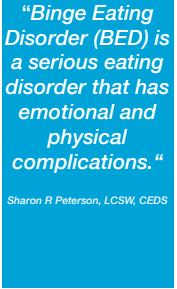What Is Binge Eating Anyway?
Binge Eating Disorder (BED) is often confused with “emotional eating” and “over eating.” First of all, we all emotionally eat from time-to-time. If we’re sad, anxious, or even excited and happy we may reach for food to help handle our strong, current feelings. Binge eating is different. In fact, it was only recently just recognized in The Diagnostic and Statistic Manual of Mental Disorders (DSM V) as being an official diagnosis and having its own category in 2013. Before that, BED was lumped in a “catch all” category called Eating Disorder Not Otherwise

Specified or ED NOS. Now BED has certain criteria that have to be met in order to be diagnosed with
the disorder.
Here are the current criteria from the DSM 5:
Binge Eating Disorder: 307.51 (F50.8)
A. Recurrent episodes of binge eating. An episode of binge eating is characterized by both of the
following:
1. Eating, in a discrete period of time (e.g., within any 2-hour period), an amount of food that is
definitely larger than what most people would eat in a similar period of time under similar
circumstances.2. A sense of lack of control over eating during the episode (e.g., a feeling that one cannot stop
eating or control what or how much one is eating).
B. The binge-eating episodes are associated with three (or more) of the following:
1. Eating much more rapidly than normal.
2. Eating until feeling uncomfortably full.
3. Eating large amounts of food when not feeling physically hungry.
4. Eating alone because of feeling embarrassed by how much one is eating.
5. Feeling disgusted with oneself, depressed, or very guilty afterward.
C. Marked distress regarding binge eating is present.
D. The binge eating occurs, on average, at least once a week for 3 months
E. The binge eating is not associated with the recurrent use of inappropriate compensatory behavior
as in bulimia nervosa and does not occur exclusively during the course of bulimia nervosa or
anorexia nervosa.
Specify if:
in partial remission: After full criteria for binge-eating disorder were previously met, binge eating
occurs at an average frequency of less than on episode per week for a sustained period of time.
In full remission: After full criteria for binge-eating disorder were previously met, none of the criteria
have been met for a sustained period of time.
Specify current severity:
The minimum level of severity is based on the frequency of episodes of binge eating (see below). The
level of severity may be increased to reflect other symptoms and the degree of functional disability.
Mild: 1-3 binge-eating episodes per week
Moderate: 4-7 binge-eating episodes per week
Severe: 8-13 binge-eating episodes per week
Extreme: 14 or more binge-eating episodes per week
Most people who are diagnosed with BED are in larger sized bodies which is difficult for them
because we still live in a society that glamorizes thinness and expects that all people should be in
“normal” thin-sized bodies. When you think about it, it doesn’t make much sense though. I mean,
do we expect everyone to be around the same height? No. Then why the heck are we all supposed
to be around the same weight?
Bingeing is not “just a lack of willpower” over your eating habits. Binge Eating Disorder is a serious
eating disorder that has emotional and physical complications. Much of our culture continues to try
to understand BED and take it seriously including those in the medical community. Too many people
mistakenly believe that Anorexia Nervosa (AN) is the most prevalent eating disorder and it’s not.
Order of Prevalence Among Eating Disorders:
1. Binge Eating Disorder (BED)
2. Bulimia Nervosa (BN)
3. Anorexia Nervosa (AN)
The good news is you can get professional help from trained eating disorder specialists including
dietitians and psychotherapists. Plus, don’t forget the size acceptance movement that’s been
sweeping across social media for several years now, trying to break down old stereotypes for larger
sized people and eradicate the prejudice that lingers among our culture.
There are also long, healthy lists of excellent nonprofits all over the country that specialize in helping
individuals and their families along with special societies for professionals treating clients with eating disorders and size acceptance. BED is finally getting the attention it rightfully deserves so people
can get the help they need.
Here is a listing of resources for BED and size acceptance organizations:
1. Binge Eating Disorder Association (BEDA)
2. National Eating Disorder Association (NEDA)
3. Health at Every Size (HAES)
4. Association for Size Diversity and Health (ASDAH)
We hope that you have found this post informative and helpful to you a family member, friend or colleague. For more information or to schedule a consultation, contact Psychotherapy Services Of Atlanta today. 404 330-4336

